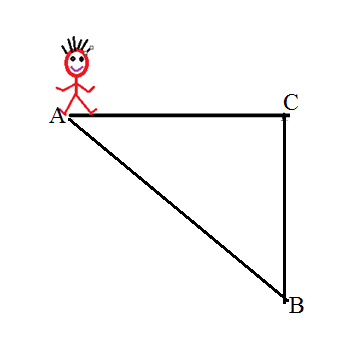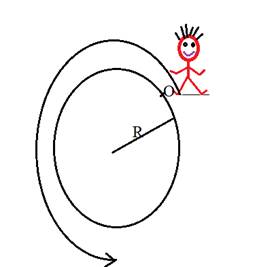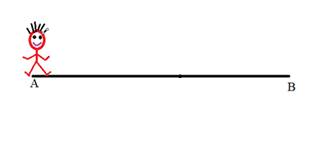
Concept explainers
To Find: Magnitude of the displacement is less than or more than the distance travelled.
Answer to Problem 1P
Magnitude of the displacement is always less than or equals to the distance travelled.
Explanation of Solution
Introduction:
Distance can be defined as the total path length travelled by a body. Its S.I. unit is
Where,
Displacement can be defined as the path difference between the initial and final position of the body. It is the minimum distance between two points.
Its S.I. unit is
Here are some examples,

Consider a body is travelling along a straight line from A to B and then B to C.
Total distance travelled by the body
Displacement of the body
Consider a body is moving in a circular path of radius
Since,
Therefore, distance travelled > displacement

Total distance traveled by the body = circumference of the circle
Displacement of the body = final position − initial position.
Here body come to its initial position after revolution
Therefore,
final position = initial position
hence,
Displacement of the body
Again, distance > displacement

Consider a body travelling in a straight line from A to B
Distance travelled = AB
Displacement = AB
Here, Displacement = Distance travelled
Conclusion:
Displacement of a body can never be greater than the distance travelled by the body. It is either equal to the distance travelled by the body or less than it.
Want to see more full solutions like this?
Chapter 3 Solutions
Physics for Scientists and Engineers
 Glencoe Physics: Principles and Problems, Student...PhysicsISBN:9780078807213Author:Paul W. ZitzewitzPublisher:Glencoe/McGraw-Hill
Glencoe Physics: Principles and Problems, Student...PhysicsISBN:9780078807213Author:Paul W. ZitzewitzPublisher:Glencoe/McGraw-Hill Principles of Physics: A Calculus-Based TextPhysicsISBN:9781133104261Author:Raymond A. Serway, John W. JewettPublisher:Cengage Learning
Principles of Physics: A Calculus-Based TextPhysicsISBN:9781133104261Author:Raymond A. Serway, John W. JewettPublisher:Cengage Learning University Physics Volume 1PhysicsISBN:9781938168277Author:William Moebs, Samuel J. Ling, Jeff SannyPublisher:OpenStax - Rice University
University Physics Volume 1PhysicsISBN:9781938168277Author:William Moebs, Samuel J. Ling, Jeff SannyPublisher:OpenStax - Rice University Physics for Scientists and EngineersPhysicsISBN:9781337553278Author:Raymond A. Serway, John W. JewettPublisher:Cengage Learning
Physics for Scientists and EngineersPhysicsISBN:9781337553278Author:Raymond A. Serway, John W. JewettPublisher:Cengage Learning Physics for Scientists and Engineers with Modern ...PhysicsISBN:9781337553292Author:Raymond A. Serway, John W. JewettPublisher:Cengage Learning
Physics for Scientists and Engineers with Modern ...PhysicsISBN:9781337553292Author:Raymond A. Serway, John W. JewettPublisher:Cengage Learning College PhysicsPhysicsISBN:9781285737027Author:Raymond A. Serway, Chris VuillePublisher:Cengage Learning
College PhysicsPhysicsISBN:9781285737027Author:Raymond A. Serway, Chris VuillePublisher:Cengage Learning





